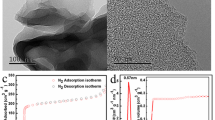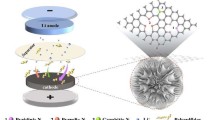Abstract
Non-polar porous carbon/doped polar carbon composite hosts have been proved effective for sulfur in lithium–sulfur (Li–S) battery. Pores in carbon can adsorb sulfur and Li2S, and nitrogen–doped surface shows a stronger affinity for polysulfides through additional chemisorptions. However, how the physical properties of doped carbon, e.g., surface area and porosity, affect the performance of the non-polar carbon/doped polar carbon composite hosts is unknown. Herein, we reported the cotton-derived carbon/porous 1-ethyl-3-methylimidazolium dicyanamide (Emim-dca) derived N-doped carbon, named C/PNC, and the cotton-derived carbon/imporous Emim-dca derived N-doped carbon, named C/NC. The surface area and porosity of the doped polar carbon in C/PNC and C/NC are controlled. The higher surface area of N-doped carbon makes more surface of cotton-derived carbon coated and more sulfur located on the surface of composite hosts. The micro-mesopores in the N-doped carbon can restrain sulfur but shows slow reactive kinetics at a higher current rate. The C/PNC cathode showed a higher discharge capacity of 1100 mAh g−1 than that of 1027 mAh g−1 for the C/NC cathode at 0.1 C and a lower capacity of 208.1 mAh g−1 than that of 349.2 mAh g−1 for C/NC cathode at 2 C.






Similar content being viewed by others
References
Hong-Jie P, Qiang Z (2015) Designing host materials for sulfur cathodes: from physical confinement to surface chemistry. Angew Chem-Int Edit 54(38):11018–11020
Zhao H, Deng N, Yan J, Kang W, Ju J, Ruan Y, Wang X, Zhuang X, Li Q, Cheng B (2018) A review on anode for lithium-sulfur batteries: progress and prospects. Chem Eng J 347:343–365
Zheng B, Yu L, Zhao Y, Xi J (2019) Ultralight carbon flakes modified separator as an effective polysulfide barrier for lithium-sulfur batteries. Electrochim Acta 295:910–917
Su Y-S, Manthiram A (2012) A new approach to improve cycle performance of rechargeable lithium-sulfur batteries by inserting a free-standing MWCNT interlayer. Chem Commun 48(70):8817–8819
Li S, Jin B, Zhai X, Li H, Jiang Q (2018) Review of carbon materials for lithium-sulfur batteries. ChemistrySelect 3(8):2245–2260
Xu Z-L, Kim J-K, Kang K (2018) Carbon nanomaterials for advanced lithium sulfur batteries. Nano Today 19:84–107
Imtiaz S, Zhang J, Zafar ZA, Ji S, Huang T, Anderson JA, Zhang Z, Huang Y (2016) Biomass-derived nanostructured porous carbons for lithium-sulfur batteries. Science China Materials 59(5):389–407
Wang M, Zhang H, Wang Q, Qu C, Li X, Zhang H (2015) Steam-etched spherical carbon/sulfur composite with high sulfur capacity and long cycle life for Li/S battery application. ACS Appl Mater Interfaces 7(6):3590–3599
Feng S, Song J, Fu S, Zhu C, Shi Q, Song M-K, Du D, Lin Y (2017) One-step synthesis of carbon nanosheet-decorated carbon nanofibers as a 3D interconnected porous carbon scaffold for lithium–sulfur batteries. J Mater Chem A 5(45):23737–23743
Nazar LF, Pang Q (2016) Long-life and high areal capacity Li-S batteries enabled by a light-weight polar host with intrinsic polysulfide adsorption. ACS Nano 10(4):4111–4118
Ji S, Imtiaz S, Sun D, Xin Y, Li Q, Huang T, Zhang Z, Huang Y (2017) Coralline-like N-doped hierarchically porous carbon derived from enteromorpha as a host matrix for lithium-sulfur battery. Chemistry 23(72):18208–18215
Peng H-J, Hou T-Z, Zhang Q, Huang J-Q, Cheng X-B, Guo M-Q, Yuan Z, He L-Y, Wei F (2014) Strongly coupled interfaces between a heterogeneous carbon host and a sulfur-containing guest for highly stable lithium-sulfur batteries: mechanistic insight into capacity degradation. Adv Mater Interfaces 1:1400227
Hou TZ, Chen X, Peng HJ, Huang JQ, Li BQ, Zhang Q, Li B (2016) Design principles for heteroatom-doped nanocarbon to achieve strong anchoring of polysulfides for lithium-sulfur batteries. Small 12(24):3283–3291
Li S, Mou T, Ren G, Warzywoda J, Wang B, Fan Z (2016) Confining sulfur species in cathodes of lithium–sulfur batteries: insight into nonpolar and polar matrix surfaces. ACS Energy Letters 1(2):481–489
Zhao Q, Zhu Q, Miao J, Guan Z, Liu H, Chen R, An Y, Wu F, Xu B (2018) Three-dimensional carbon current collector promises small sulfur molecule cathode with high areal loading for lithium-sulfur batteries. ACS Appl Mater Interfaces 10(13):10882–10889
Wang Z, Xue D, Song H, Zhong X, Wang J, Hou P (2019) Hierarchical micro-mesoporous carbon prepared from waste cotton textile for lithium-sulfur batteries. Ionics 25(9):4057–4066
Wu H, Shi L, Lei J, Liu D, Qu D, Xie Z, Du X, Yang P, Hu X, Li J, Tang H (2016) Nitrogen and sulfur co-doped carbon with three-dimensional ordered macroporosity: an efficient metal-free oxygen reduction catalyst derived from ionic liquid. J Power Sources 323:90–96
Li Z, Jiang Y, Yuan L, Yi Z, Wu C, Liu Y, Strasser P, Huang Y (2014) A highly ordered meso@micro-porous carbon supported sulfur@smaller-sulfur core-shell structured cathode for Li-S batteries. ACS Nano 8(9):9295–9303
Yang CP, Yin YX, Guo YG, Wan LJ (2015) Electrochemical (De)lithiation of 1D sulfur chains in Li-S batteries: a model system study. J Am Chem Soc 137(6):2215–2218
Wang J (2003) Polymer lithium cells with sulfur composites as cathode materials. Electrochim Acta 48(13):1861–1867
Zhang B, Lai C, Zhou Z, Gao XP (2009) Preparation and electrochemical properties of sulfur–acetylene black composites as cathode materials. Electrochim Acta 54(14):3708–3713
Wang D-W, Zhou G, Li F, Wu K-H, Lu GQ, Cheng H-M, Gentle IR (2012) A microporous-mesoporous carbon with graphitic structure for a high-rate stable sulfur cathode in carbonate solvent-based Li-S batteries. Phys Chem Chem Phys 14(24):8703–8710
Wang M, Zhang Y, Zhang H, Zhang H (2014) A microsized cagelike sulfur/carbon composite for a lithium/sulfur battery with excellent performance. ChemPlusChem 79(7):919–924
Li Z, Yuan L, Yi Z, Sun Y, Liu Y, Jiang Y, Shen Y, Xin Y, Zhang Z, Huang Y (2013) Insight into the electrode mechanism in lithium-sulfur batteries with ordered microporous carbon confined sulfur as the cathode. Adv Energy Mater 4(7):1301473
Zhang J, Li J-Y, Wang W-P, Zhang X-H, Tan X-H, Chu W-G, Guo Y-G (2018) Microemulsion assisted assembly of 3D porous S/graphene@g-C3N4 hybrid sponge as free-standing cathodes for high energy density Li-S batteries. Adv Energy Mater:1702839
Tian Y, Sun Z, Zhang Y, Wang X, Bakenov Z, Yin F (2018) Micro-spherical sulfur/graphene oxide composite via spray drying for high performance lithium sulfur batteries. Nanomaterials 8(1):50
Luo R, Lu Y, Hou X, Yu Q, Wu N, Peng T, Yan H, Liu X, Kim J-K, Luo Y (2018) Evolution of hollow N-doped mesoporous carbon microspheres from outdated milk as sulfur cathodes for lithium-sulfur batteries. ChemistrySelect 3(14):3952–3957
Wen X, Xiang K, Zhu Y, Xiao L, Chen X, Chen H (2018) Preparation of Mn3O4 -CNTs microspheres as an improved sulfur hosts for lithium-sulfur batteries. Mater Lett 229:272–276
Funding
This work is supported by the National Natural Science Foundation of China (No. 51902275), the Hunan Provincial Natural Science Foundation of China (No. 2020JJ4288), the Special Fund of the State Key Laboratory of Intense Pulsed Radiation Simulation and Effect (No. SKLIPR1911), the Scientific Research Fund of Hunan Provincial Education Department (No. 20B225 and 20B560), and Open Fund of Hunan Provincial Key Laboratory of Advanced Materials for New Energy Storage and Conversion (2018TP1037-202002).
Author information
Authors and Affiliations
Corresponding author
Ethics declarations
Conflict of interest
The authors declare no competing interests.
Additional information
Publisher’s note
Springer Nature remains neutral with regard to jurisdictional claims in published maps and institutional affiliations.
Rights and permissions
About this article
Cite this article
Cheng, J., Wang, Z., Song, H. et al. Effects of physical properties of N-doped carbon on carbon/N-doped carbon/sulfur composite cathodes. Ionics 27, 3271–3279 (2021). https://doi.org/10.1007/s11581-021-04097-8
Received:
Revised:
Accepted:
Published:
Issue Date:
DOI: https://doi.org/10.1007/s11581-021-04097-8




